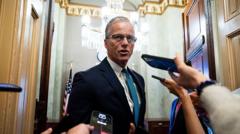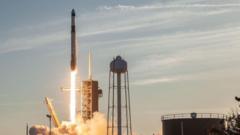With the success of robotic missions like NASA's Parker Solar Probe, experts ponder whether AI and robotics can fully replace human astronauts for future space exploration. While there are advantages to using robots, human presence continues to offer inspiration and versatility that machines may lack.
The Future of Space Exploration: AI Robots vs. Human Astronauts

The Future of Space Exploration: AI Robots vs. Human Astronauts
As autonomous spacecraft demonstrate advanced capabilities, the debate intensifies over the necessity of human astronauts in space exploration.
Despite past achievements with human crews, advancements in AI technology and robotic systems spark discussions around the future role of astronauts in exploring frontiers beyond Earth. As robots take on more tasks traditionally performed by humans, the fundamental question arises: will future explorers be more human or machine?
As one of the most significant advancements in space exploration, NASA's Parker Solar Probe made history on Christmas Eve by flying closer to the Sun than any previous man-made craft. Capable of executing pre-programmed missions with no direct human involvement, the probe shines a light on the growing capabilities of autonomous robots in space. Over the past sixty years, robotic probes have charted parts of the solar system that are too dangerous for human crews, fostering a conversation about the necessity of sending astronauts into space as technology progresses.
Notable scientists like Lord Martin Rees, the UK’s Astronomer Royal, argue against the allocation of taxpayer funds for human missions. By emphasizing the costs and dangers associated with human space travel, Rees suggests that the fate of humans in space should be left to private ventures. Similarly, Andrew Coates from University College London champions robotic missions, highlighting their greater reach and efficiency over human counterparts.
However, the debate isn't solely focused on cost. Psychological and educational components deeply entwine with human space exploration. Dr. Kelly Weinersmith of Rice University points out that humans bring a unique capability to engage audiences and inspire society in ways that robots cannot. Similarly, Leroy Chiao, a retired astronaut, emphasizes that human endeavors in space continue to generate excitement on Earth, a sentiment not matched by robot explorations.
Despite their limitations—robots being slow and methodical—robots are increasingly playing roles that enhance human efforts in space. NASA's Curiosity rover, for instance, operates autonomously to gather data and perform scientific experiments, but its capabilities still cannot match the adaptability of human thinking and emotional engagement. Researchers argue that the future might see a hybrid approach, where humans and robots collaborate rather than compete.
The potential for cutting-edge AI technologies remains a focal point in this conversation. Dr. Kiri Wagstaff describes how AI could alleviate astronauts’ workloads by automating tedious tasks, thus freeing them to focus on critical research. Yet, with the current power limitations on rovers, the full integration of advanced AI into robotic systems still remains a challenge.
The human versus robotic space exploration dialogue continues to evolve, especially with ambitious projects such as NASA's Artemis program set to potentially return humans to the Moon, and Elon Musk envisioning crewed colonies on Mars. While advocates for human exploration highlight the intangible benefits—such as inspiration and a deeper understanding of humanity's role in the universe—robotic adventurers promise to push the boundaries of our exploration capabilities. As we venture into the cosmos, the synergy between human ingenuity and robotic efficiency may define the next era of space exploration.
As one of the most significant advancements in space exploration, NASA's Parker Solar Probe made history on Christmas Eve by flying closer to the Sun than any previous man-made craft. Capable of executing pre-programmed missions with no direct human involvement, the probe shines a light on the growing capabilities of autonomous robots in space. Over the past sixty years, robotic probes have charted parts of the solar system that are too dangerous for human crews, fostering a conversation about the necessity of sending astronauts into space as technology progresses.
Notable scientists like Lord Martin Rees, the UK’s Astronomer Royal, argue against the allocation of taxpayer funds for human missions. By emphasizing the costs and dangers associated with human space travel, Rees suggests that the fate of humans in space should be left to private ventures. Similarly, Andrew Coates from University College London champions robotic missions, highlighting their greater reach and efficiency over human counterparts.
However, the debate isn't solely focused on cost. Psychological and educational components deeply entwine with human space exploration. Dr. Kelly Weinersmith of Rice University points out that humans bring a unique capability to engage audiences and inspire society in ways that robots cannot. Similarly, Leroy Chiao, a retired astronaut, emphasizes that human endeavors in space continue to generate excitement on Earth, a sentiment not matched by robot explorations.
Despite their limitations—robots being slow and methodical—robots are increasingly playing roles that enhance human efforts in space. NASA's Curiosity rover, for instance, operates autonomously to gather data and perform scientific experiments, but its capabilities still cannot match the adaptability of human thinking and emotional engagement. Researchers argue that the future might see a hybrid approach, where humans and robots collaborate rather than compete.
The potential for cutting-edge AI technologies remains a focal point in this conversation. Dr. Kiri Wagstaff describes how AI could alleviate astronauts’ workloads by automating tedious tasks, thus freeing them to focus on critical research. Yet, with the current power limitations on rovers, the full integration of advanced AI into robotic systems still remains a challenge.
The human versus robotic space exploration dialogue continues to evolve, especially with ambitious projects such as NASA's Artemis program set to potentially return humans to the Moon, and Elon Musk envisioning crewed colonies on Mars. While advocates for human exploration highlight the intangible benefits—such as inspiration and a deeper understanding of humanity's role in the universe—robotic adventurers promise to push the boundaries of our exploration capabilities. As we venture into the cosmos, the synergy between human ingenuity and robotic efficiency may define the next era of space exploration.


















